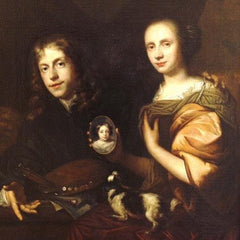Jan de Baen was a renowned Dutch Golden Age portraitist who worked predominantly in The Hague for distinguished aristocratic patrons.
Hailing from Haarlem in the Dutch Republic, de Baen’s father worked in the flourishing linen and flax trade at a time when the city was at the heart of linen production. European merchants sent their wares to the city for bleaching and finishing, as described in Jacob van Ruisdael’s ‘View of Haarlem with Bleaching Fields’. It’s conceivable that de Baen would’ve pursued the same vocation, especially given the abundance of opportunities, but by the age of three, he’d become an orphan.
Following the loss of his parents, he was raised by his uncle, the magistrate and painter, Hinderk Pyman (or Piemans), who taught him the rudiments of drawing and painting. From here, he moved to the vibrant port city of Amsterdam, where he undertook further tuition with Jacob Adriaensz Backer (1608-1651), a pupil of Rembrandt’s who was well-versed in portraiture.
Backer died in 1651, but de Baen remained in Amsterdam, keen to establish a foothold in the art market. Examples of his work from this period are scarce, with two of the earliest being an etching of the ‘Burning of Amsterdam Town Hall’ (1652) and a portrait of the merchant Willem van der Voort, which is at the Historisch Museum.
With his reputation growing, he came to the attention of Charles II during his time in exile, and it’s believed that he undertook work for the English court. In 1666, now restored to the throne, the King, evidently impressed with the young man, summoned him to England presumably with an offer of patronage. However, somewhat surprisingly, de Baen declined and returned to The Hague. He did, however, accept the role of court painter to the House of Orange.
De Baen was remarkably popular and regarded highly by patrons for his flattering style. He tended to work with several formulaic poses but still, more often than not, managed to encapsulate the character of each sitter. He studied the works of Anthony van Dyck (1599-1641) extensively and sought to inject a sense of dignity into each of his portrayals. His depiction of William III when Prince of Orange (c.1667) hangs in the Chatsworth Room at Hampton Court Palace.
His son was the painter Jacobus de Baen (1673-1700), and his other pupils included Johann Friedrich Bodecker, Denys Godijn, Hendrik van Limborch, Nicolaes van Ravesteyn, Petro van Rijs, Jan van Sweel, and Johannes Vollevens.
He’s represented in numerous public collections, including at The British Museum and the National Portrait Gallery in London.
Public Collections
Ashmolean Museum in Oxford, Royal Collection Trust, National Maritime Museum, The British Museum, National Portrait Gallery in London, National Trust (at Dyrham Park, Hatchlands, and Nostell Priory), The Fitzwilliam Museum.
Timeline
1633
Born in Haarlem, Holland, Dutch Republic. His father was a merchant in linen and flax.
C.1636-c.1645
Lived with his uncle, the magistrate and painter, Hinderk Pyman (or Piemans), in Emden.
1645/6-1648
Trained under Jacob Adriaensz Backer in Amsterdam, where he lived until 1660.
Worked for Charles II of England.
1660-1702
Worked predominantly in The Hague.
1665
Married Maria de Kinderen. The pair would have at least eight children, including Jacob de Baen (1672-c. 1700) who became an artist.
1666
Travelled to London following a summons by King Charles II.
1702
Died in The Hague.


